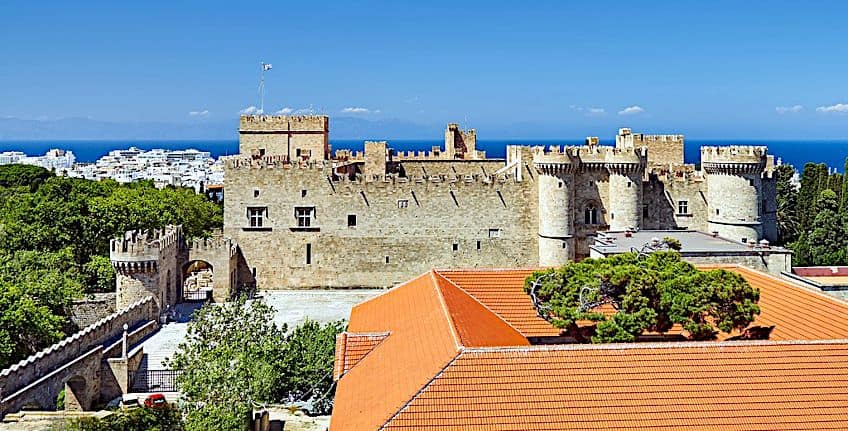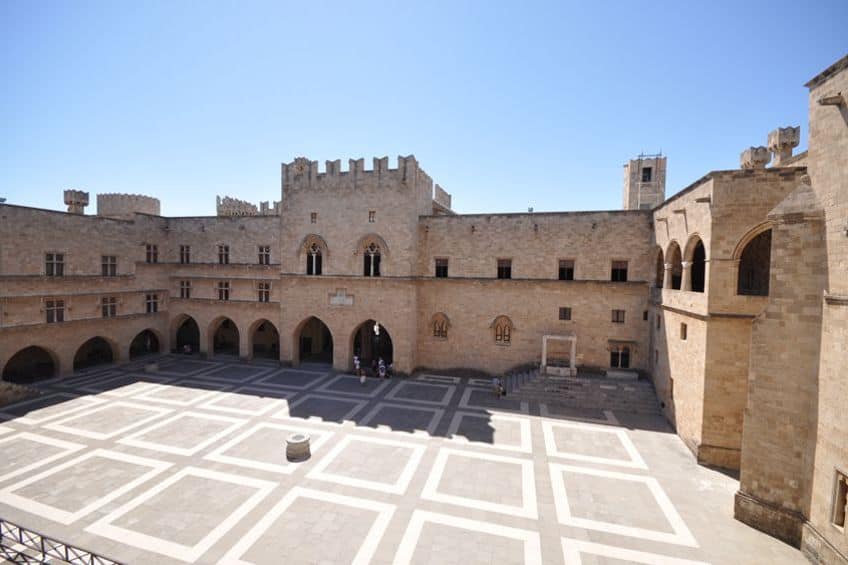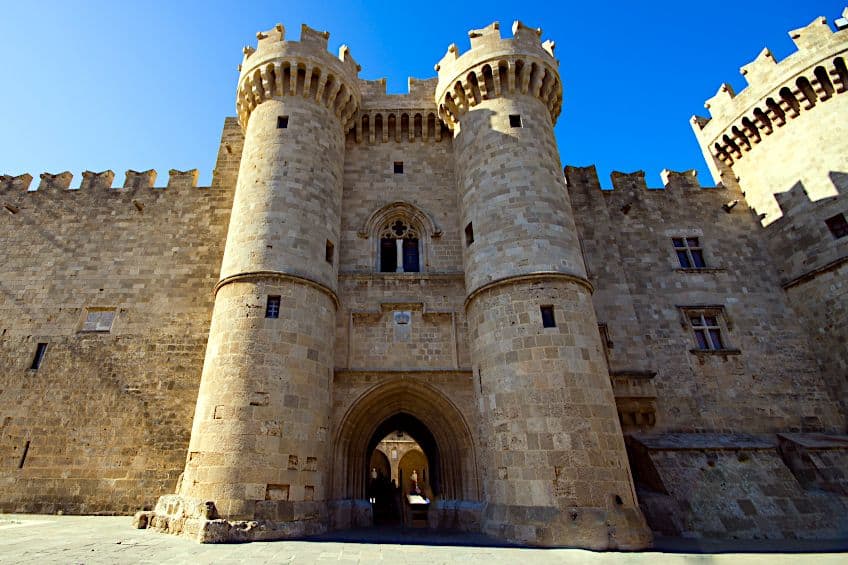Grand Master Palace of Rhodes – A Detailed History
The Palace of the Grand Master of the Knights of Rhodes, also known as the Grand Master Palace of Rhodes, is a gorgeous Byzantine-era structure situated in Rhodes, Greece. In this article, we will discuss this ancient structure’s history, architecture, residential, and contemporary uses. Keep reading to learn more about the Grand Master Palace of Rhodes!
A Look at the Palace of the Grand Master of the Knights of Rhodes
| Architect | Unknown |
| Date Constructed | 7th century (original citadel) |
| Function | Museum |
| Materials Used | Stone and marble |
| Location | Rhodes, Greece |
The Grand Master Palace of Rhodes is a magnificent Byzantine citadel turned museum located on the Greek island of Rhodes. This fortress structure would go through a long and tumultuous history as it changed hands several times and even served as a home to a dictator. So, let’s have a look at that history.
The History of the Palace of the Grand Master of the Knights of Rhodes
Greece is one of the most ancient civilizations on Earth, and as such, it holds some of the most ancient structures ever constructed by humans. In the case of the Palace of the Grand Master in Rhodes, this structure was built atop a far older temple. The temple dates back to the Ancient Greek period and was dedicated to Helios, the Greek god of the sun, but after it eventually fell apart, a palace was built atop the ruins. Rhodes was one of the most important locations in Ancient Greece, and it is believed that the location that now houses the Grand Master Palace of Rhodes was also the location at which the Colossus of Rhodes once stood. For those unfamiliar, this gigantic statue was one of the Seven Wonders of the Ancient World, and it was a colossal statue that stood over the port in Rhodes.
The Colossus of Rhodes, to possibly operate alongside the ancient temple that has since been replaced by the Palace of the Grand Master in Rhodes, was a statue that depicted Helios as he watched over the harbor.
This indicates that even in ancient times, this location was one of immense importance to the Greek people. Times would eventually change for the Ancient Greek people as the Romans became the dominant force in the region. They effectively replaced the Greeks as the most powerful hegemony. The Romans would then, over time, fragment into two main regions. One of those regions, the Western Roman Empire, would fall, but the Eastern Roman Empire would not. That Eastern Empire later became known as the Byzantine Empire.
The Byzantine Empire was the most powerful force in Europe for several centuries, and during this period, the island of Rhodes was controlled by the empire. In the late-7th century, they constructed a citadel. This citadel would remain for several centuries, but as the Byzantine Empire also started to collapse, the area fell into disrepair. It was then, in 1309, that the Knights Hospitaller entered the island and occupied it (alongside several other Greek islands). They quickly took over the old citadel, converted it into a fortress/governmental facility/palace, and set about controlling the region. During this period, they also repaired the structure and made significant additions.

The building would later be damaged by an earthquake but repaired. Things only changed in 1522 when the Ottoman Empire conquered the island and turned the Castle of Rhodes into their own fortress. Only with their collapse did the island and the castle change hands. Only in the late-1930s, during Italian rule over the island, was the Grand Master Palace of Rhodes restored once again.
The Castle of Rhodes no longer had any true strategic value by the 20th century and so it instead became a national landmark of sorts and was even used as a residence for a time. Ever since 1948, when independence was restored to the region and the island was handed back to Greece, the Palace of the Grand Master of Rhodes became a museum. It has served this role ever since.
The Architecture of the Palace of the Grand Master of the Knights of Rhodes
The Palace of the Grand Master of Rhodes, being an ancient Byzantine citadel, was constructed from the kinds of hardy materials one might expect. The original structure was made of stone, but when the Knights Hospitaller entered the region and took over, some of their additions would supplement the structure with marble additions. There were also extensive changes made, such as new decorative elements and inscriptions. In addition to this, one of the most stunning sights in the palace is the mosaic floor that had been taken from a Roman villa. This mosaic was made of a variety of stones as well as marble. Furthermore, when Vittorio Mesturino, an Italian architect was given the task of restoring the ancient castle in the late-1930s, he added a fountain and numerous statues. He also repaired much of the structure with marble.
The exterior of the Grand Master Palace of Rhodes can be expected of such a structure.
It is a fortified castle made of stone that was designed around a rectangular plan with four corner towers that keep a watch over all. In typical castle fashion, the building also includes two massive, fortified gates and a moat that encircles the building as a whole. When the Knights Hospitaller took over the region and renovated the castle, they made many additions to the façade of the Grand Master Palace of Rhodes. They added numerous decorations, inscriptions, and reliefs along the walls. This is one of the most distinctive features of the structure to this day. The courtyard in the center of the Grand Master Palace of Rhodes also contains a fountain with a very famous statue. This statue is not actually the statue, but rather a replica of it. The statue is one of the most famous in all of Ancient Greece, and it is known as Laocoön and His Sons. The original statue is on display in the Vatican Museums.

The interior of the Grand Master Palace of Rhodes entails a variety of styles as one group after another seized control of the region and the castle. There are elements of medieval, Gothic, and Renaissance architectural styles throughout the interior, and some of those interior spaces include stunning frescoes, mosaic floor designs, cross-vaulted ceilings, and even a fireplace decorated in fascist iconography. That last feature is a holdover from when a certain person used the Grand Master Palace of Rhodes as a residence.
The Palace of the Grand Master of the Knights of Rhodes as a Residence
One of the more peculiar things to happen to the Grand Master Palace of Rhodes was that it became, for a few brief years, a private residence. When Rhodes fell under Italy’s rule, the Castle of Rhodes was quickly used by Victor Emmanuel III as a holiday home. However, he was not the only famous Italian figure of the 20th century who used this location as a holiday home.
It was also used by the Fascist dictator, Benito Mussolini, for a similar purpose. In fact, there is even a plaque indicating this right at the entrance to the building.
The Current Uses of the Palace of the Grand Master of the Knights of Rhodes
Today, the Castle of Rhodes has become a museum and exhibition facility. Some of the exhibits include artworks from the island, like mosaic floor designs, exhibitions about Rhodes during the ancient and medieval periods, and an array of medieval furniture. In addition to being a museum, the Grand Master Palace of Rhodes is also used to host a variety of cultural events.

We have come to the end of our discussion about the Palace of the Grand Master of the Knights of Rhodes. This ancient citadel-turned-fortress-turned-museum is one of the most spectacular sights in Rhodes. In this article, we discussed the history, architecture, residential uses, and contemporary purpose of this ancient castle in Rhodes. Hopefully, you have learned a good deal about it, but there is always more to learn about Rhodes, ancient Greece, and the Byzantine Empire.
Frequently Asked Questions
What Is the Palace of the Grand Master of the Knights of Rhodes?
The Grand Master Palace of Rhodes was a Byzantine citadel that eventually became the chief location of the Knights Hospitaller. Thereafter, the fortress changed hands and was used by the Ottoman Empire from 1522 until the end of the First World War. Thereafter, it became a residence and, finally, a museum.
Where Is the Palace of the Grand Master of the Knights of Rhodes?
The Grand Master Palace of Rhodes is located in Rhodes, which is one of the most famous Greek islands. The Castle of Rhodes may have also once been near the location at which the Colossus of Rhodes was situated.
Who Designed the Palace of the Grand Master of the Knights of Rhodes?
The architect of the Grand Master Palace of Rhodes is unknown, but it was originally constructed by the Byzantine Empire. It was later repaired, and additions were made by the Knights Hospitaller. It then, over time, gradually fell into disrepair until it was restored in the late-1930s by Vittorio Mesturino, an Italian architect.
Who Has Lived in the Palace of the Grand Master of the Knights of Rhodes?
The Grand Master Palace of Rhodes was used as a citadel, and therefore effectively served as a residence of sorts for many Byzantine, Knights Hospitaller, and Ottoman forces. However, once the region had become an Italian territory, it was used as a holiday residence by Victor Emmanuel III, the King of Italy, and later by Benito Mussolini, the leader of the Fascist Party in Italy.
What Is the Palace of the Grand Master of the Knights of Rhodes Used for Today?
The Grand Master Palace of Rhodes is now used as a museum and exhibition facility. However, it is also used to host events. Additionally, it has been classified as a UNESCO World Heritage Site in 1988.
Justin van Huyssteen is a writer, academic, and educator from Cape Town, South Africa. He holds a master’s degree in Theory of Literature. His primary focus in this field is the analysis of artistic objects through a number of theoretical lenses. His predominant theoretical areas of interest include narratology and critical theory in general, with a particular focus on animal studies. Other than academia, he is a novelist, game reviewer, and freelance writer. Justin’s preferred architectural movements include the more modern and postmodern types of architecture, such as Bauhaus, Art Nouveau, Art Deco, Brutalist, and Futurist varieties like sustainable architecture. Justin is working for artfilemagazine as an author and content writer since 2022. He is responsible for all blog posts about architecture.
Learn more about Justin van Huyssteen and about us.
Cite this Article
Justin, van Huyssteen, “Grand Master Palace of Rhodes – A Detailed History.” artfilemagazine – Your Online Art Source. August 7, 2023. URL: https://artfilemagazine.com/grand-master-palace-of-rhodes/
van Huyssteen, J. (2023, 7 August). Grand Master Palace of Rhodes – A Detailed History. artfilemagazine – Your Online Art Source. https://artfilemagazine.com/grand-master-palace-of-rhodes/
van Huyssteen, Justin. “Grand Master Palace of Rhodes – A Detailed History.” artfilemagazine – Your Online Art Source, August 7, 2023. https://artfilemagazine.com/grand-master-palace-of-rhodes/.



